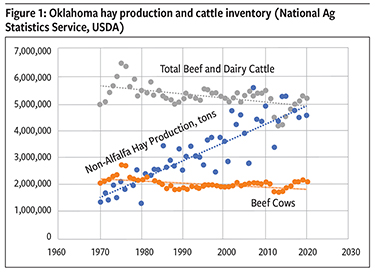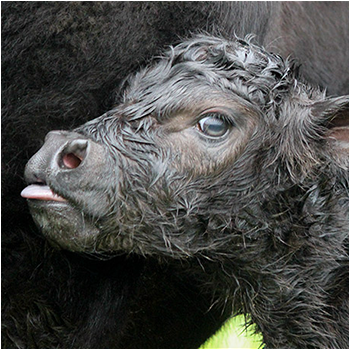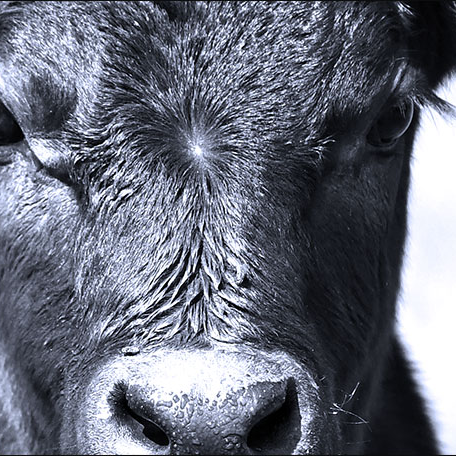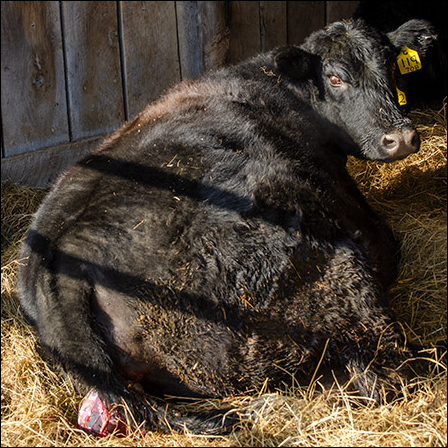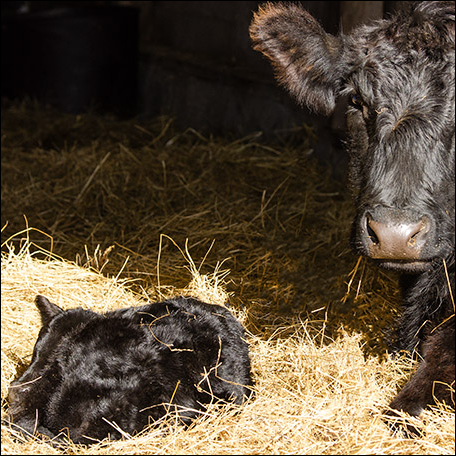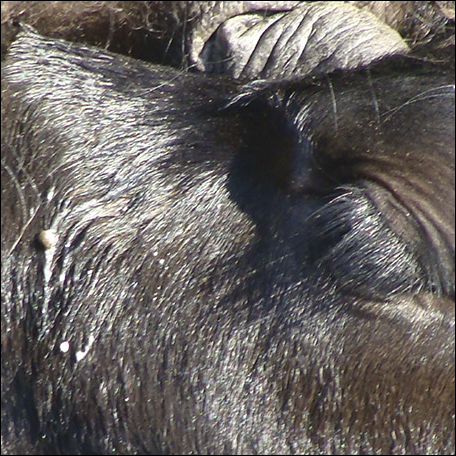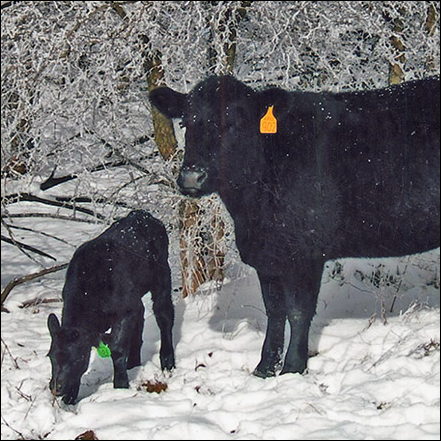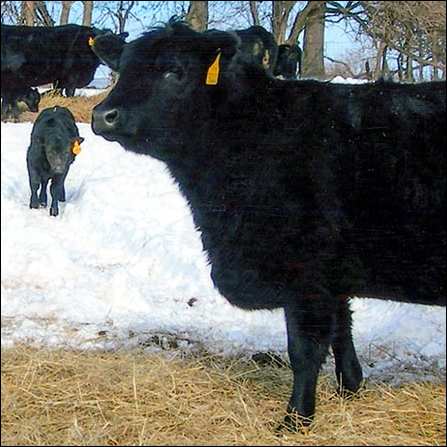Angus Advisor
Our team of Angus advisors offer regional tips for herd management for the winter season.
Southern Great Plains
david.lalman@okstate.eduIn the previous “Angus Advisor” column, I summarized differences between highly profitable and lesser profitable commercial cow-calf operations. In summary, two different benchmarking programs demonstrate a negative relationship between profitability and nonpasture feed costs.
Nonpasture feed costs include purchased and harvested feeds, as well as the equipment, land and labor associated with growing, harvesting, storing and feeding. In light of this negative relationship and the longer growing season in the Southern Great Plains, it may be a surprise that hay production continues to increase relative to total cattle or beef cow inventory (Figure 1).
Obviously not all hay produced in Oklahoma is utilized by the beef cattle industry. However, dairy cow numbers have declined dramatically from 110,000 milk cows in 1983 to about 40,000 milk cows in 2014 and remaining stable since then.
The horse industry has declined from a peak of 326,000 head in 1986 to about 250,000 head in 2017. Hay imports and exports have been relatively consistent over time. Therefore the majority of hay produced in Oklahoma is utilized by the beef cattle industry, and the majority is used by beef cows and their calves.
Hay production per beef cow has increased from about three-quarters of a ton in the mid ’70s to about 2.25 tons per beef cow more recently (Figure 1). Multiple factors likely contribute to the trend for increasing reliance on harvested forage over the years.
For example, the invention of the large round baler in the early 1970s, along with continued improvements in harvesting machinery, could explain a good bit of the increase. From a physical labor and time standpoint, hay production is a lot more convenient and efficient today.
Escalating land costs per cow-calf unit might explain some of this trend. In other words, hay feeding may be used to intensify cattle carrying capacity on a given land base. Increased hay production on cropland in lieu of harvesting a grain crop and increased harvesting of summer cover crops likely contribute.
Minimizing harvested forage storage and feeding loss should surely be a point of emphasis in operations that rely on purchased or harvested hay. Recently our beef cattle extension group hosted Kevin Shinners, University of Wisconsin–Madison, in our Ranchers’ Thursday Lunchtime Series (beef.okstate.edu).
Shinners’ presentation was well-received, and is getting a lot of views. His practical tips on outdoor round bale hay storage could lead to substantial reductions in hay waste and improvements in feed quality. A few of his suggestions include:
- Start with tight, dense round bales using net wrap. This creates a thatch that will shed water.
- Butt round bales tightly together end-to-end in rows.
- Stack bales on a well-drained south-facing slope, if possible.
- Stack rows north to south if possible to maximize exposure of both sides of the bales to the sun.
- Leave rows far enough apart to allow airflow and sunlight to reach the bottom third of bales. Rows stacked close enough to touch will wick moisture and limit or eliminate airflow.
- Leave rows far enough apart to control vegetation with a mower. This increases air flow and sunlight exposure.
- Moisture-wicking and bottom spoilage can be dramatically reduced by stacking bales on a rock bed or raising the bales off the ground using other materials.
Reducing reliance on harvested forage should be a high priority in most Southern Great Plains cow-calf enterprises. At the same time, with the increase in use of harvested forage in this region, minimizing storage and feeding loss should also represent an opportunity to improve enterprise profitability.
I realize this is a winter column, and most folks will be feeding hay — not stacking it. Hopefully sharing these ideas now will give you time to consider action steps for your operation during the next hay harvest season. I will share practical tips to minimize feeding waste in a future “Angus Advisor” column.
Western Region
randyp@csufresno.eduFall–calving herds Main Focus: getting cows bred
- 1. Return inseminations. If you are artificially inseminating (AI) on return heats, give a gonadotropin-releasing hormone (GnRH) injection at the time of breeding as it has been proven to increase conception rates on repeat inseminations. I like to switch bulls and not breed the female back to the same AI sire I used on the first service.
- 2. Natural-service sires. Bulls are probably already turned out or will be shortly. If females are in pastures where they are easily observed, record natural service dates and watch for return heats in cows that have been naturally covered by bulls. If a high percentage of the females that have been naturally covered by bulls are coming back into estrus, replace the bull if that is an option.
- 3. Mineral supplementation. Mineral supplementation is important in achieving optimal reproductive performance. The breeding season is the most critical period to be certain that females are achieving adequate mineral consumption. I prefer using a combination of both injectable and consumable mineral products.
- 4. Protein and energy supplementation. It is critical both protein and energy requirements of females are being met during the breeding season. Females should be in a state of positive energy balance or gaining weight during the breeding season, as energy balance has a significant influence on fertility or conception rate. Body condition is your best gauge to determine if you are meeting energy requirements. For protein, it is best to watch fecal output. If the females’ fecal output is loose, and the “cow pies” flatten out on the ground, protein intake is OK. If the fecal output looks more like a horse’s fecal output, the cows are deficient on protein.
- 5. Vaccinations. Calves should receive their first round of vaccinations. Producers should consult with their veterinarian in developing their vaccination protocol. I recommend calves are at least 45 to 60 days old before they receive their first round of vaccinations. This can cause a problem if you have some late clean-up sired calves. In these situations, I like to vaccinate the AI-sired calves about 30 days before the clean-up sired calves. In many operations, this practice may not be practical.
- 6. Bottom-end bull calves. Calves should be old enough by now to identify the bottom end of the bull calves. I recommend producers look at bull calves with a critical eye and a sharp knife. In most herds I think the bottom 20% of bull calves should be castrated, and I personally believe this should be determined based on phenotypic quality only.
Spring–calving herds Main Focus: the calving season
- 1. Calving supplies. Supplies should be on hand, and proper equipment should be available to assist females with problems at calving. Be sure your personnel are properly trained in the most current procedures recommended for assisting females that are experiencing calving difficulties.
- 2. Colostrum. In order for maximal absorption of maternal antibodies, calves should nurse within the first six hours after birth. A supply of frozen colostrum could be kept on hand, or a colostrum replacement or supplement could be used. Extra milk from a mature cow taken shortly after calving is the best source of frozen colostrum.
- 3. Retained placentas. Watch for retained placentas and treat those cows promptly. If the cows have not cleaned by 24 hours, we administer a prostaglandin injection as the first treatment. If they don’t clean in response to injection, we administer another prostaglandin injection combined with a treatment of antibiotics either given intramuscularly (IM) or mixed with sterile water and infused directly into the uterus.
- 4. Body condition score (BCS). The target level of body condition at calving is a BCS of 5.0 (scale = 1 to 9) for mature cows and 6.0 for 2-year-old heifers. Both protein and energy requirements need to be met in order to achieve the desired level of body condition.
- 5. Bull and heifer development. Both bulls and heifers should be performing at levels that will allow achievement of desired average yearling weights. Our target levels of performance here at the university when developing bulls and heifers from weaning to yearling is 3.0 to 3.5 pounds (lb.) per day for bulls and 1.0 to 1.5 lb. per day for heifers.
- 6. Treatment protocols. Have treatment protocols and products on hand for both scours and pneumonia in suckling calves.
- 7. Selection of AI sires. Although the breeding season is still months away, now is the time to start developing a list of potential AI sires. In my opinion, this is the single most important factor determining the success of purebred cattle operations.
- 8. Development of a marketing program. Winter is also a good time to put some serious thought into developing a creative and effective marketing program. If you do not feel comfortable in this area, there are numerous marketing consultants who can provide excellent advice in this area.
Southeast Region
jduggin@uga.eduDon’t worry. I won’t be mentioning the previous 12 months. There are already enough “I still can’t believe it” moments on the farm that there is no need to mention 2020. We have all experienced crazy moments on the farm. The craziest experiences I’ve witnessed will not soon be forgotten.
Here are a few crazy stories before we get into the main topics: 1) cow sticking its head through a 1.5 foot (ft.) x 1.5 ft. opening in the top of a $20,000 hydraulic chute to almost hang itself — the hole was later blocked; 2) Heifers ganging up on another heifer to turn her upside down in a feed trough; 3) Instead of a steer walking down the front ramp of a semitrailer down into the lower front compartment, it tried to jump across the 5-ft. gap onto the top front compartment. It didn’t clear the jump and got a front leg caught on the top floor door. Luckily, we got the leg free and the steer was fine. These are not fun experiences.
Still, the biggest challenges on the farm often come from situations we likely could have prevented. Each year I get at least one call from a producer concerned about his conception rate or cattle not looking like they should.
This is generally tied with a winter breeding, and a slide in body condition that goes unnoticed. Low-quality or even average-quality hay can really do a lot of damage when we aren’t prepared, particularly with cold temperature snaps.
The remedy is testing every lot of hay and getting a plan together to fill in the nutritional gaps with commodities or mixed feeds when grazing has ceased. If hay is the main form of nutrition, cows in peak lactation need hay to be 12% crude protein (CP) and at least 60% total digestible nutrients (TDN). Cows weighing 1,200 lb. need 24 lb. of dry matter a day. Not meeting these needs during breeding is one of the leading causes of an “I still can’t believe it” episode.
Although not as commonly reported, baleage not properly put up can bring on some troubling times. Baleage wrapped with too much moisture can turn high-quality forage into a bad situation. Ideally baleage is ensiled within a moisture window of 50%-60%.
If baleage moisture exceeds a threshold of approximately 60%, fermentation may not proceed correctly. Poor fermentation can cause the ensiled forage to not provide sufficient nutrition cattle can adequately metabolize.
Although cattle may even have a great appetite for this baleage, they can lose weight in noticeable amounts. Baleage that exceeds 70% moisture, particularly, has the potential to create one of those “I still can’t believe it” moments. A traditional nutritional analysis will not pick up a fermentation issue.
If you receive a nutritional analysis that reports overly high moisture, other samples should be submitted to specific labs that can measure fermentation. Getting these reports can help prevent big problems.
Midwest Region
baileyeric@missouri.eduWhat does a successful cow-calf operation look like when it is “in stride?” I suspect there will be many opinions, from enormous weaning weights to 100% conception rate. Here are my two cents on this topic.
A well-managed cow herd has a specific calving season distribution, rather than calves spread throughout the calving season. If you split the calving season into thirds, having more than 50% of calves born in the first third of the calving season tells me a lot about your operation.
The most obvious is a large portion of your cows were ready to be bred at the start of the breeding season.
How do we get cows to be ready to breed on Day 1 of the breeding season? Cows must be in good body condition (score of around a 5 on a 1-9 scale) if most are bred soon after bulls are turned out.
BCS and plane of nutrition (gaining weight = positive plane of nutrition) greatly influence when cows begin to cycle prior to the next breeding season. Research suggests a normal postpartum interval is around six weeks after calving under normal circumstances. If cows are at a BCS greater than 5 at calving, the postpartum interval increases and can be as long as 90 days if BCS is less than 4 at calving.
Remember, the estrous cycle in cows is about 21 days, and pregnancy is about 285 days. Cows have to be bred within one to two estrous cycles to stay on a 365-day calving interval. If cows breed back one cycle later each year, it will not be long before they fall out of the herd due to failure to conceive within your defined breeding season.
Having calves born early in the calving season is not just good for reproductive outcomes. Imagine a scenario in which the first calf is born on Feb. 1 and the last calf is born 90 days later. Also assume calves are evenly spaced throughout the calving season. The average birth date of a calf in the imaginary herd is around March 15.
Now assume calving season is 90 days, but half of the calves are born in the first 30 days of calving, a quarter in the second 30 days, and a quarter in the third 30 days. Your average birth date is March 8, which does not seem like a big difference. However, if calves are seven days older at weaning and gain 2.5 lb. per day before weaning, that is an extra 17.5 lb. of weaning weight, with zero input. At $1.50 per lb. sales price for weaned calves, your calves are worth an extra $26.25 per head.
The scenario above is realistic. I’ve seen well-managed herds have calving season distributions with more than 70% of calves born in the first one-third of the calving season. How do we get there? We need to make sure cows go into calving at a BCS of 5 and gain weight (other than fetal growth) going into calving.
Far too many operations across the country calve in the winter on forages inadequate to meet a beef cow’s nutrient requirements. The first 60 days after calving are peak nutrient needs for cows.
My solution for this scenario is to calve on green grass. In other words, match peak nutrient requirements of the cow herd with peak nutrient quality of your forage base. I doubt it would be profitable to supplement to meet winter-calving cows’ nutrient requirements across much of the country.
Let your forage base absorb as much of the nutritional needs of cows as possible, and watch how your calving season distribution changes. It will put more dollars in your pocket with little to no additional effort.
